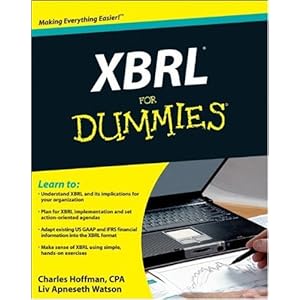|
What is XBRL and how can it help you streamline your business reporting? This plain-English guide from the "father of XBRL," Charles Hoffman, will tell you what it is, why it is, and how you can get on the bus with this new SEC-mandated business reporting standard for publicly-traded companies. A CPA, Hoffman is credited with the idea of applying XML data to financial reporting; XBRL is the language that resulted. Learn to prepare financial statements with XBRL, use it for strategic planning, move all relevant departments in your company to the same system, and more. XBRL (eXtensible Business Reporting Language) is an XML-based open standard for accounting data; author Charles Hoffman is credited with the idea of applying XML data to financial reportingPlan for XBRL implementation, set action-oriented agendas, and identify stakeholders and subject-matter experts within your organizationLearn to choose from and adapt existing XBRL taxonomies to comply with US GAAP and IFRS standards Topics also include how to adapt your existing financial information into XBRL.
From the Back CoverLearn to: Understand XBRL and its implications for your organization Plan for XBRL implementation and set action-oriented agendas Adapt existing US GAAP and IFRS financial information into the XBRL format Make sense of XBRL using simple, hands-on exercises Are you ready for XBRL? Get up to speed with this friendly guide! Extensible Business Reporting Language — XBRL — is revolutionizing business reporting, including financial reporting. It's complicated, but this book isn't! Here's how to get business and IT folks on the same spreadsheet so that everyone can grasp the concept and be ready for the switch. You'll discover the important details you need to make smart business and technical decisions about XBRL. What is it? — understand what XBRL is, its parts, and how it works Learn from the masters — discover how gurus including Marc van Hilvoorde; Christine Tan, PhD; Raynier van Egmond; and Eiichi Watanabe put XBRL to work Information, please — see how information is used and why new ways to exchange it are necessary Making it happen — be able to identify stakeholders, find a common vocabulary, and build an implementation team Step by step — see how to create and use XBRL modules and taxonomies Visit the companion Web site at www.dummies.com/go/xbrl to find links to URLs in the book and bonus material Open the book and find: Common misconceptions about XBRL Ten ways to make learning XBRL easier A look at the information supply chain How to make a business case for XBRL Pitfalls to avoid All about meeting the SEC mandate The future of business information exchange Various implementation approaches
|
2011年9月13日星期二
XBRL For Dummies--Free PDF Ebook Download
订阅:
博文评论 (Atom)

没有评论:
发表评论